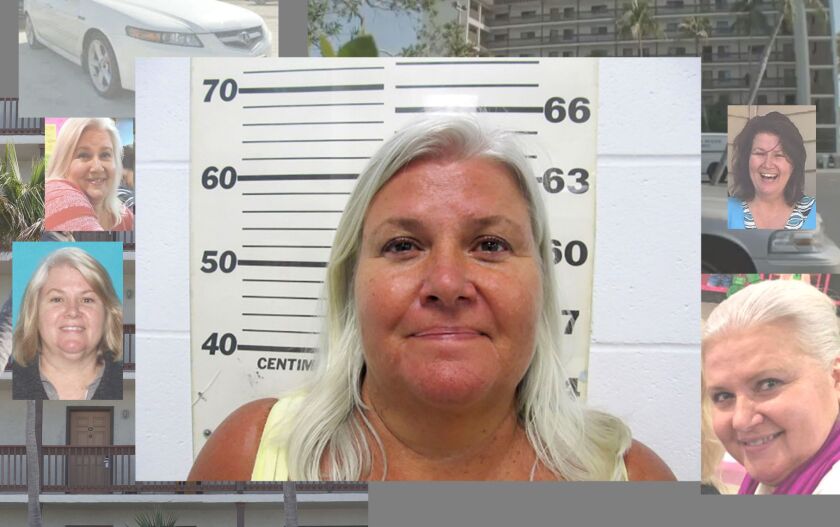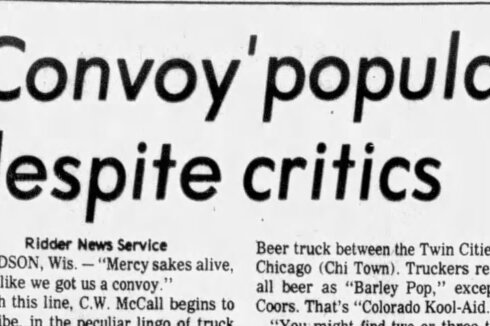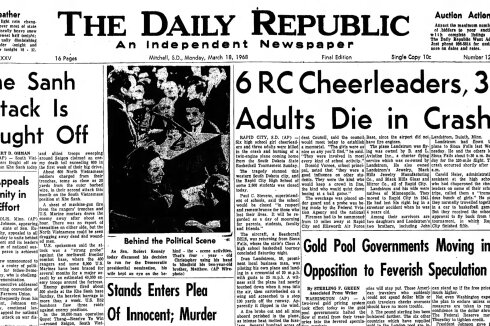Editor's note: This archival Vault story was first published Nov. 30, 2021.
SUNBURG, Minn. — Forty-one-year-old Neil Pladson was found strangled to death with his hands and feet bound June 26, 1988, in a blood-splattered St. Paul apartment.
ADVERTISEMENT
His killer, 24-year-old Douglas Tank, told a Ramsey County court that Pladson had threatened to kill his family and was brandishing a knife.
“He had a knife and I knocked it out of his hand and started strangling him, choking him,” Tank said in court.
Tank was sentenced to a little over nine years after pleading guilty to first-degree manslaughter.
Tank had good reason to believe Pladson’s threats.
Pladson had been convicted of the 1970 shotgun slayings of a Sunburg family of five. The youngest victim of the mass murderer was a 4-year-old.
Tank, who had served time in prison with Pladson during his 16-year stint for his crimes, would know all too well what Pladson was capable of.
Every piece of investigative information gleaned from the Kandiyohi County Sheriff’s Office file on Pladson points to an unbalanced and odd character.
ADVERTISEMENT
Someone who bragged about the killings while in pretrial detention.
Someone who killed his dog on the same November day when he murdered an entire family.
Pladson, an U.S. Air Force veteran, had been committed on at least one occasion and sought treatment through the Veterans Administration.
Friends and family would describe him as an unhinged guy who often did off-putting things, like randomly dig holes throughout the yard with a pitchfork or violently lash out at people.
Robert Rathburn, a friend of Pladson's, told law enforcement that Pladson was a loner who "wanted to be loved."
The rural Sunburg scene
Dilbert Peterson, the milkman, was the first person to discover James Fremberg’s body in the barn around 10:30 a.m. Nov. 15, 1970.
ADVERTISEMENT
Peterson could hear the milk machines running and went into the barn to find James lying on the floor with blood near his head.
Peterson then went to the house and shouted to see if anyone was home.
Finding no answer, he rushed to his milk truck and raced across the road to Harold Mithaugen’s house to get help.
Mithaugen, his wife, Jean, and his brother-in-law then accompanied Peterson back to the farm.
Peterson followed Mrs. Mithaugen into the house while the other men went into the barn.
Inside the house, they would find the bodies of Gloria Fremberg, 29, Patricia Ann Fremberg, 8, David James Fremberg, 7, and Douglas Mark Fremberg, 4.
All were dead and their faces had been covered.
ADVERTISEMENT
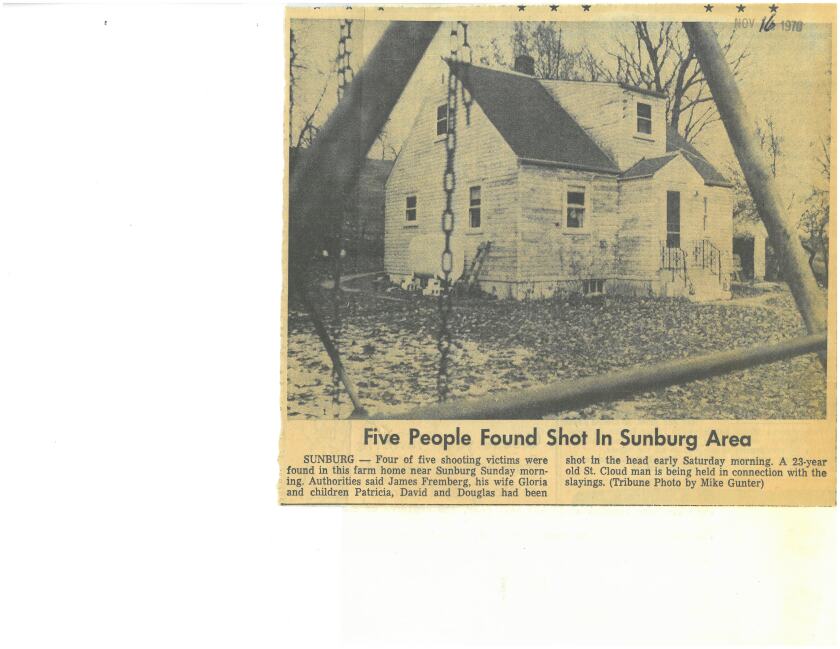
When Kandiyohi County Sheriff Harvey M. Spaulding walked into the Fremberg farm the morning of Nov. 15, 1970, he first saw the body of Gloria Fremberg in the dining room with her head almost completely shot off, lying on her right side with her knees pulled up, dressed in a white sweatshirt and blue jeans, blue socks and no shoes.
He then walked upstairs to a bedroom to find the bodies of the three children — Patricia in a bed by herself and brothers David and Douglas in a bed together.
All three had been shot in the face.
The patriarch of the family, James Fremberg, 40, was found shot in the face lying in a vestibule between the cattle in a barn on the property.
All five had been killed by 12-gauge shotgun slugs the day prior.
The autopsy photos show the brutality of what a shotgun can do at close range.
Read more:
ADVERTISEMENT
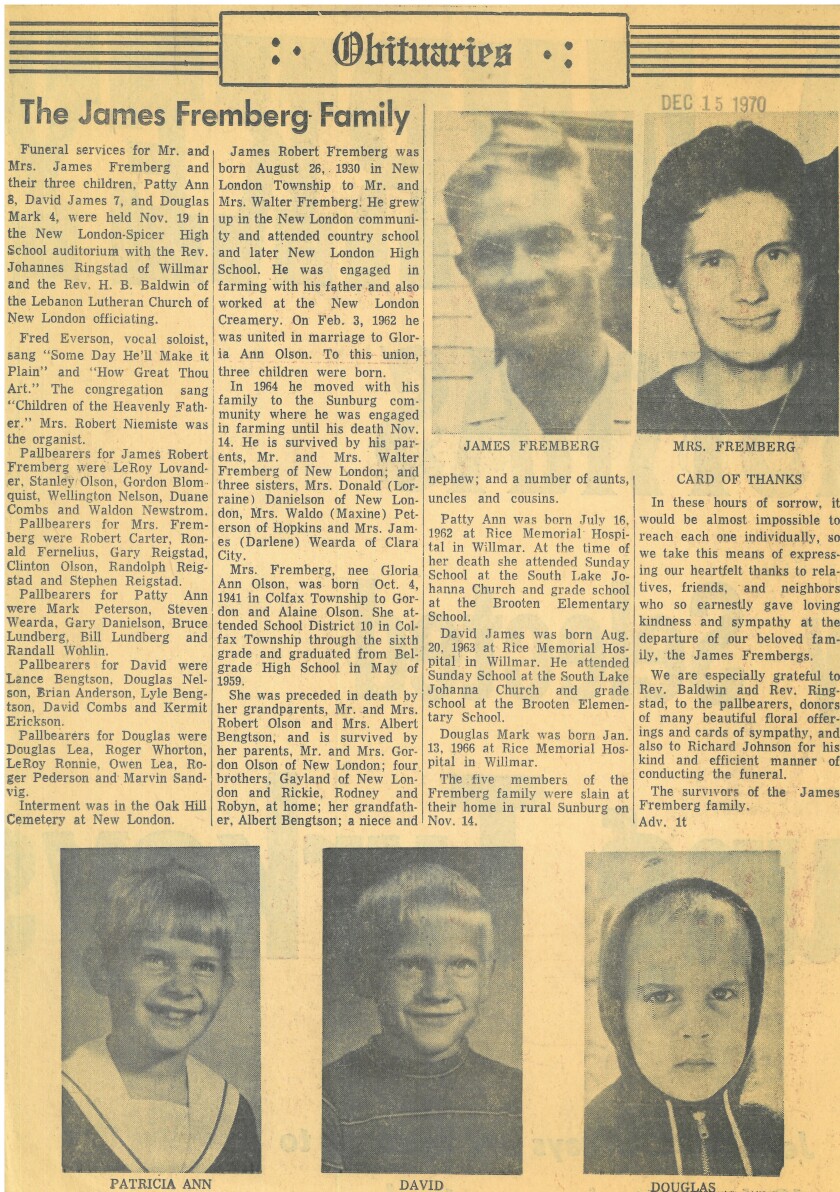
The investigation
Investigators quickly zeroed in on Pladson — a 23-year-old from St. Cloud — and arrested him shortly after the killings.
Multiple witnesses interviewed by Spaulding and Agent John Barry of the Minnesota Crime Bureau said they saw Pladson in the woods in the area that day.
It was the deer hunting opener and the land was well tracked by those looking to bag a deer.
Investigators would learn during these interviews that the Pladson family had once lived in the Frembergs' home.
According to Arnold Pladson, Neil’s father, the house was sold to the Frembergs a decade prior with the Pladson family moving to St. Cloud.
A neighbor of the Frembergs would tell law enforcement that Gloria Fremberg had unexpectedly been forced to confront Neil and several other people going through the home about a year prior.
ADVERTISEMENT
Pladson denied any involvement in the killings during the initial interview.
His father, Arnold, told investigators that he and Neil had driven together to Pope County to hunt on Nov. 14, arriving at about 6:30 a.m.
Neil then left around 6:50 a.m. with a 12-gauge shotgun and his dog in a 1967 dark blue Chevrolet that Arnold owned. Neil would not come back until a few minutes after 10 a.m.
When Neil came back, he grabbed a 16-gauge shotgun out of the vehicle, telling his father he was out of shells for the 12-gauge because he had done some shooting while he was gone.
During Neil’s initial interview with police, he told them he saw a nice buck and shot at it once. When asked what happened to the other six shells he had, Neil looked surprised and said that he fired them into the air.
He would later tell police during an interview in the Kandiyohi County Jail that he shot seven times at that buck.
When law enforcement asked for and received the clothes Neil was wearing that day, blood was immediately noticeable.
The reason for the blood, Neil Pladson told investigators, was that he had shot his dog that afternoon because the two were getting too close. He then said he gutted the dog with a hunting knife and then carried him to a spot to be buried in Pope County.
When asked, Pladson could not explain why he cut the dog though he did tell them where it was buried.
An autopsy of the dog showed the dog had indeed been cut in the stomach and had been shot.
Blood group testing on the clothes Pladson gave police found the same blood groups of the Frembergs.
Autopsies of the Frembergs would show the parents had empty bladders while the children’s were full, indicating that the children had not gotten out of bed before being shot at close range.
David Fremberg’s autopsy revealed gas impression from the gun powder on the right side of his face and charring around the mouth, indicating the gun had been placed in his mouth prior to firing.
About 800 people would attend the family’s funeral.
Read more:
The trial and commitment
Pladson appeared in November 1970 in a Kandiyohi County District courtroom where he pleaded not guilty to five counts of first-degree murder.
Read more:
- Pladson indicted for first-degree murder Nov. 19, 1970
- Pladson pretrial articles from Nov. 20, 1970, to Feb. 24, 1971
- Reports of examination of physical evidence
In December, his defense attorney would ask the court to have Pladson undergo a psychiatric evaluation, which Judge Leif R. Langsjoen would grant later that month.
During his time in jail awaiting trial, Pladson would tell an inmate and a jailer that he shot the family.
By March of 1971, Pladson was ruled insane and in need of treatment.
During Pladson’s sanity hearing, Dr. Glenn Lewis, a Minneapolis psychiatrist who evaluated Pladson, told the court that Pladson was suffering from a mental disorder under which he had grandiose thinking and believed there was an alleged conspiracy against him and had thought about killing other people.
"I could kill children, go home and take my own children out for a walk and be perfectly trustworthy," Pladson told evaluators.
Pladson had received care from the VA for his psychosis about a year prior to the murders.
Lewis would testify in court that Pladson told him there were “too many people on the land,” as the reason why he killed the Frembergs.
Lewis also told the court that Pladson told him he killed his dog because he believed the dog had superpowers and might kill him after witnessing Pladson kill other humans.
Pladson also did not understand all of the proceedings against him, according to Lewis.
Following the testimony and the judge’s ruling that Pladson be committed to a state security hospital, Pladson asked Lewis if he really thought he was confused.
Lewis told him yes due to the testing that had been done.
“I guess there are 13 different ways you can kill a man with your hands,” Pladson replied.
Following that hearing, Pladson would tell a jailer that he killed the family, according to an investigative report.
“It was a bloody mess,” Pladson said.
He would also confess to fellow inmates and even to law enforcement.
On Dec. 31, 1970, Pladson would tell law enforcement "I am guilty of the five counts," and that he "wanted to get out."
Pladson spent a little over a year in the Minnesota Security Hospital at St. Peter before he was deemed competent to stand trial.
Facing a potential trial with a mountain of evidence against him, Pladson pleaded guilty Nov. 8, 1972, to five counts of third-degree murder .
Judge Langsjoen would sentence Pladson to 25 years for each count, though the sentences would run concurrently. The prosecution had requested they run consecutively.
Langsjoen would say during sentencing that further treatment at the state hospital would be preferable.
Pladson would later appeal to the Minnesota Supreme Cour t that he was promised that he would spend his entire time in the state hospital but that appeal was rejected . He also sought to reduce his prison sentence for time served. That was also denied.
He would spend the next 16 years shifting from Stillwater State Penitentiary and the St. Peter State Security Hospital before being released to a halfway house in January of 1987.
By June 1988, Pladson would be bound and strangled to death by his roommate.





